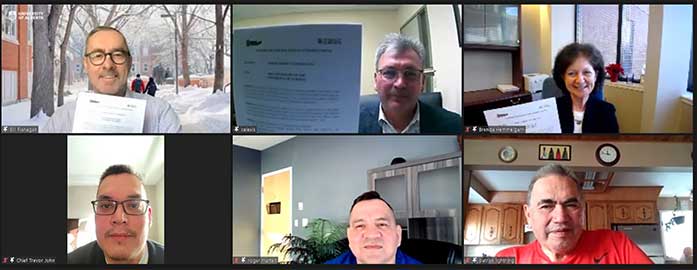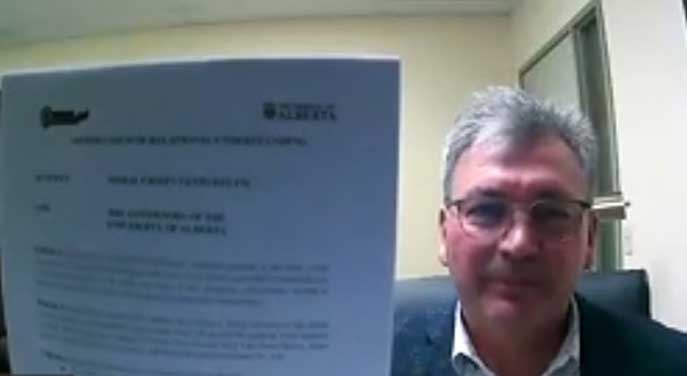Six northeastern Alberta First Nations have formed a new partnership with the University of Alberta to train more Indigenous physicians and improve health care for their members.
The memorandum of relational understanding between the university and Tribal Chiefs Ventures Inc., which represents Beaver Lake Cree Nation, Cold Lake First Nation, Frog Lake First Nation, Heart Lake First Nation, Kehewin Cree Nation, and Whitefish Lake First Nation No. 128, was signed on Wednesday during a virtual ceremony.
“I am excited about this memorandum of relational understanding and the potential it has to promote learning opportunities in the sciences and medical fields for the youth of the Tribal Chiefs Ventures Inc. member First Nations to choose meaningful career paths,” said Cameron Alexis, chief executive officer of Tribal Chiefs Ventures Inc.
“There is a need for Indigenous medical practitioners – physicians, psychologists, psychiatrists, nurse practitioners, RNs, dentists and others – to help address the needs of First Nations peoples,” Alexis said.
“A key part of our faculty’s mission is to serve the public through partnerships and innovation, on a solid foundation of social accountability,” said Brenda Hemmelgarn, dean of the Faculty of Medicine & Dentistry. “To do this, we know we must integrate meaningful input from partners like Tribal Chiefs Ventures Inc.”

(Clockwise from top left) U of A president Bill Flanagan, Tribal Chiefs Ventures Inc. CEO Cameron Alexis, Faculty of Medicine & Dentistry dean Brenda Hemmelgarn, Elder Rick Lightning from Maskwacîs, Cold Lake First Nations Chief Roger Marten and Kehewin Cree Nation Chief Trevor John hold copies of the new memorandum of relational understanding signed Dec 15, 2021
Unlike a traditional memorandum of understanding, the new agreement focuses on the relationships that will lead to success.
“It’s based on the world view that we are all connected,” said Wayne Clark, executive director of the U of A’s Indigenous Health Initiatives Program. “When we respect Indigenous world views and find ways to work together, we will achieve harmony and build trusting partnerships to reach our shared goals.”
Clark expects to see progress made in three areas. The first is recruitment of more Indigenous medical school applicants, including First Nations, Inuit and Métis, as well as urban and non-status students.
“This is why the community needs to be involved in some of the decision-making,” said Clark, who is Inuk registered under the Nunavut Agreement. “It’s really about equity, and ensuring that we have fair practices and policies to help us identify the best candidates for the program.”
The second target area is to improve all trainee physicians’ understanding of the challenges First Nations peoples face within the health-care system. This will be achieved through the curriculum in the classroom and experiential learning within the communities.
The third focus is to find innovative educational solutions to health-care gaps with Indigenous peoples. “What can we do to offer education that can help ensure better overall system improvement, so there’s culturally safe care, earlier diagnoses, better care planning, for example?” Clark asked.
Noting the agreement is the first of its kind, Clark said he expects to see the university create future partnerships supporting Indigenous research practices and priorities. Such agreements are a step toward achieving the 94 Calls to Action of the Truth and Reconciliation Commission of Canada, he said.
“I’d like to see these kinds of partnerships right across northern Alberta,” Clark said. “Whenever we make decisions – with the programs that we design and how we evaluate them – we have to involve the community in order to be successful.”
Also in attendance at the virtual signing ceremony were Grand Chief Greg Desjarlais of Frog Lake First Nation, who is chair of Tribal Chiefs Ventures Inc.; Elder Rick Lightning; Florence Glanfield, U of A vice-provost of Indigenous programming and research; and Bill Flanagan, U of A president and vice-chancellor.
| By Gillian Rutherford
Submitted by the University of Alberta’s Folio online magazine. The University of Alberta is a Troy Media Editorial Content Provider Partner.
© Troy Media
Troy Media is an editorial content provider to media outlets and its own hosted community news outlets across Canada.


